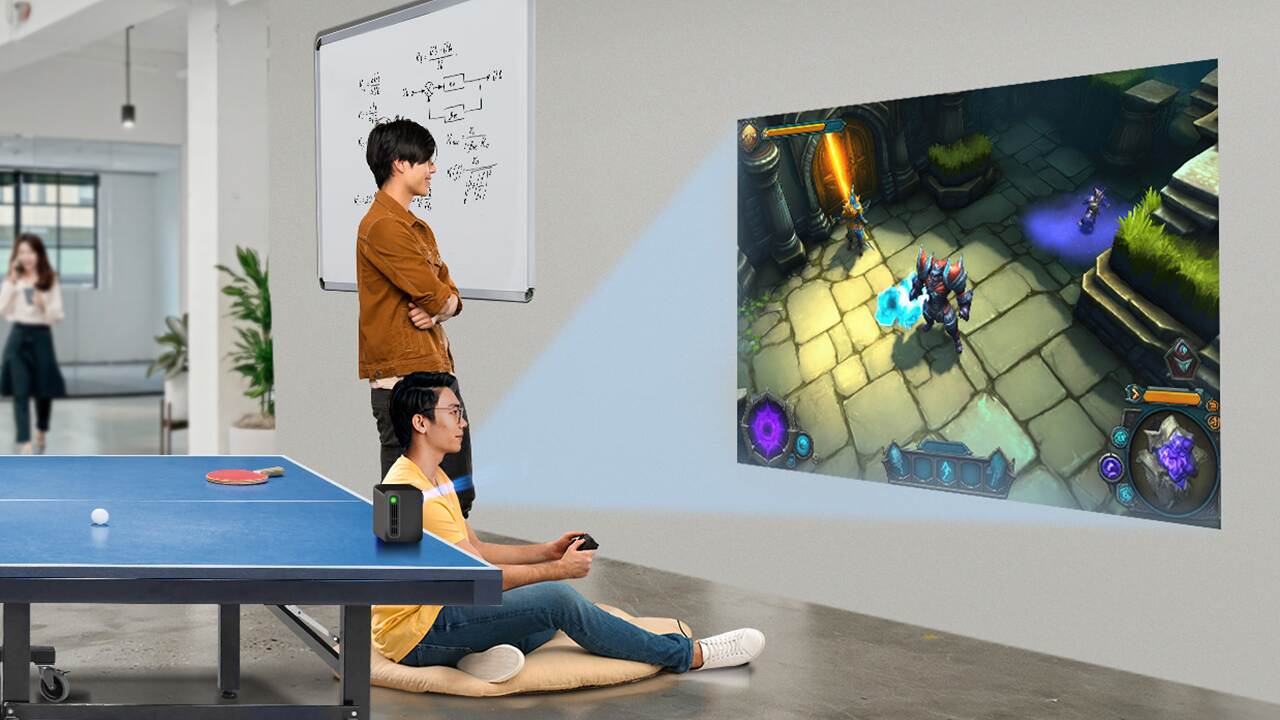SSZTD03 October 2023 DLP230NP , DLP471TP
Resolution is a critical specification for any display. For projectors, a higher resolution can make a measurably positive impact to the viewing experience with more lifelike, detailed images.
But the high bill-of-materials cost of high-resolution 1080p and 4K ultra-high-definition (UHD) projection systems have kept these types of projectors out of reach for many consumers. So in this article, I’ll focus on two ways product designers can bring lower-cost, smaller high-resolution mobile projectors to market.
Mobile projector cost is primarily driven by two design considerations: the display chipset and the optomechanical system.
A lower cost display chipset with1080p or 4K UHD resolution will enable product designers and projector brands to meet the high-resolution standards of modern streaming content, video games (see Figure 1) and laptop computers, while offering consumers a new entry-level product position.
 Figure 1 A battery-powered 1080p mobile
smart TV can enable gaming on the go
Figure 1 A battery-powered 1080p mobile
smart TV can enable gaming on the goThe other significant contributor to projection system cost is the optomechanical system, including the illumination architecture and thermal management. Brighter LED-illuminated projectors, such as those using four-channel LED illumination, drive costs higher because of the increased cost of the LEDs and optics, and require more thermal management in order to cool LEDs operating at such high power levels. A simpler three-channel red-green-blue LED architecture is preferable for entry-level mobile projectors and enables the highest efficiency, a smaller heat sink, and the lowest possible illumination costs.
Independent of the projection system, designers can also consider a reduced set of projector features. For example, a fully featured projector may include wireless connectivity, a smart TV operating system, automatic screen fit/warping, autofocus, premium audio and battery power. Removing or reducing some or all of these features can save costs and help designers differentiate their products.
Lower-cost display chipsets for lower-cost projection systems
Two new DLP® Pico chipsets enable a new standard for entry-level 1080p and 4K UHD DLP Pico mobile projectors. The DLP230NPSE and DLP471TPSE chipsets deliver full HD 1080p and 4K UHD resolutions, respectively, at a lower cost compared to previous 1080p and 4K UHD DLP chipsets.
The DLP230NPSE and DLP471TPSE chipsets are pin-to-pin and optically compatible with TI’s previous 0.23-inch 1080p DLP230NP and 0.47-inch 4K UHD DLP471TP chipsets, respectively. Suppliers of existing optical DLP230NP and DLP471TP modules will be able to offer new lower-cost versions, and system integrators will simply need to replace the DLP controller and update the DLP firmware in their solutions.
The new chipsets enable reduced illumination power consumption, which allows designers to significantly reduce the cost of the thermal management system, including the heat sink and fan. Not only will reduced illumination power consumption reduce heat-sink costs, but it will also reduce the size of the thermal management system. For example, a 50% reduction in illumination power will result in a required heat-sink size roughly one-third the original size. Such a significant reduction in the size of the heat sink can help make the projector both lighter and smaller.
Conclusion
Whether playing a new video game rendered in 1080p or watching a 4K UHD movie outside with neighbors, high-resolution mobile projectors can enable unique, memorable experiences. The DLP230NPSE and DLP471TPSE chipsets can help make high-resolution mobile projectors more portable and affordable.
Additional resources
- Order the DLP LightCrafter™ Display 230NP or 471TP evaluation modules.
- Read the application note, “TI DLP System Design: Brightness Requirements and Tradeoffs,” and the application report, “TI DLP Pico System Design: Optical Module Specifications.”